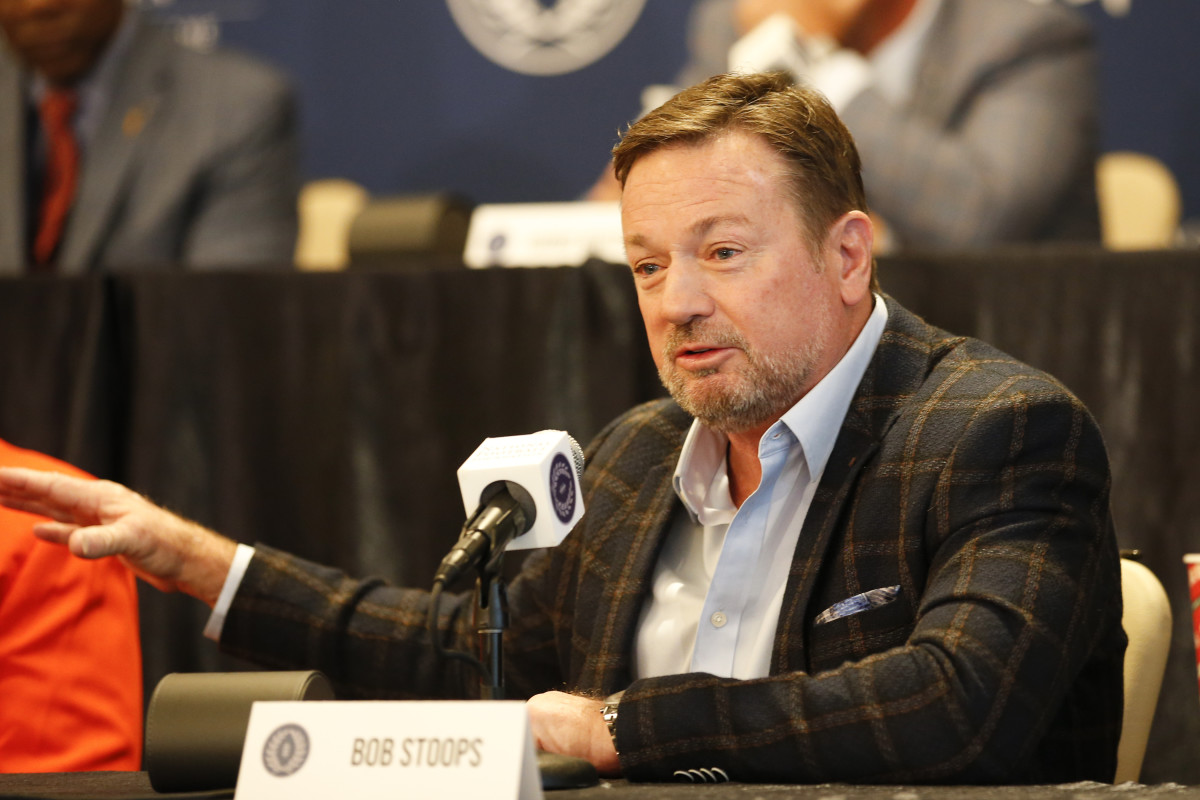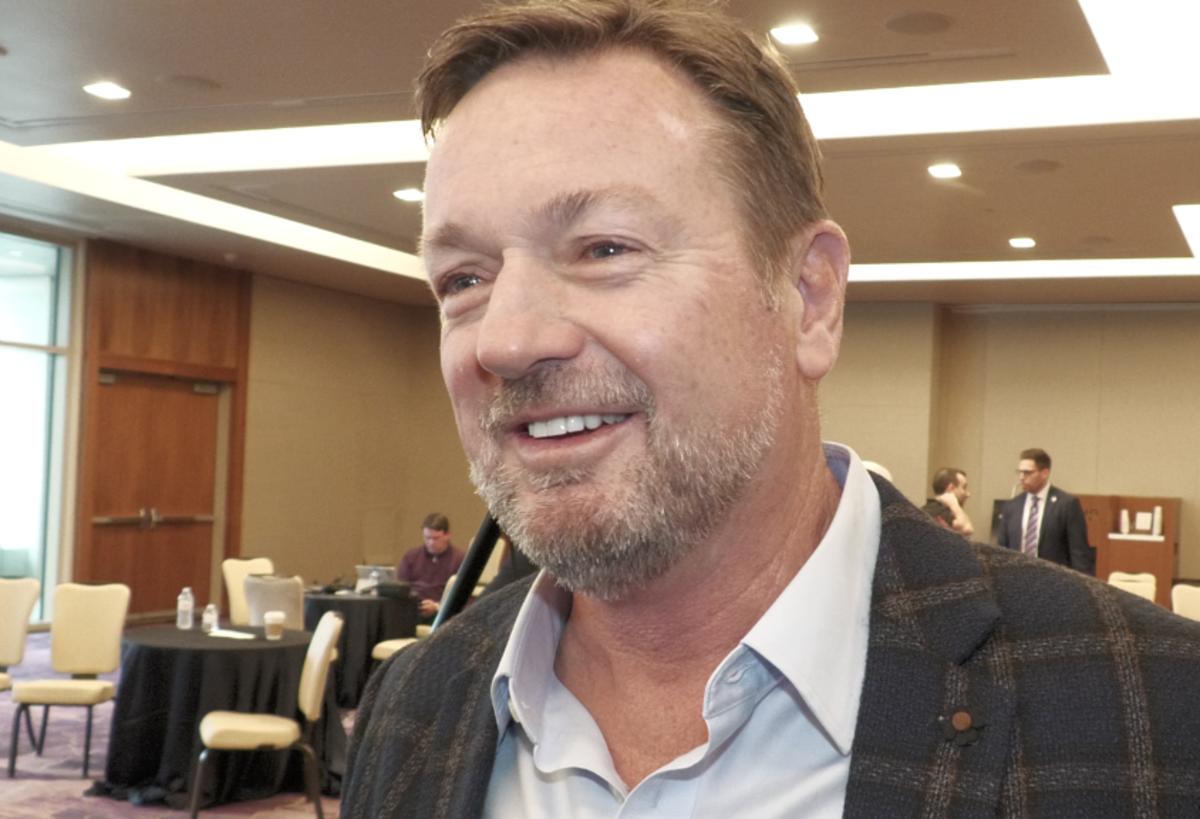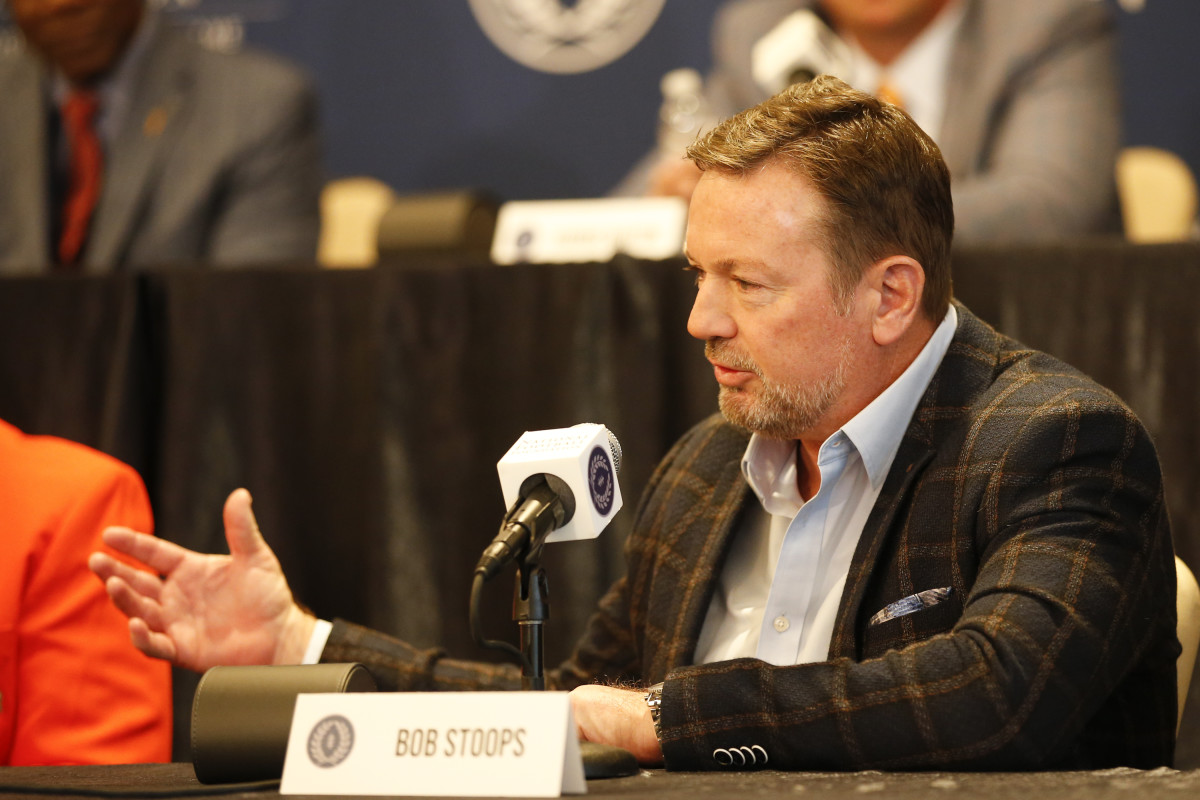Oklahoma's Bob Stoops Rode Confidence Into the College Football Hall of Fame

LAS VEGAS — From the family's humble home on Detroit Avenue to the College Football Hall of Fame, Bob Stoops’ journey has been one filled with leadership, toughness, loyalty, positivity and, maybe above all, confidence.
“I’ve never been around anybody,” Oklahoma athletic director Joe Castiglione said Monday, “that has more confidence than Bob Stoops.”
“People follow his leadership,” said long-time friend and former OU assistant Mark Mangino, “because they believe in his confidence.”

Stoops, 61, is being enshrined in the National Football Foundation and College Hall of Fame on Tuesday night during a gala at the Aria Hotel and Resort. New and shiny and nestled between iconic locales like Caesar’s Palace, the Bellagio and the Waldorf Astoria, it’s a long way from Stoops’ gritty Youngstown roots.
Still, Stoops doesn’t look at his tough steel-town childhood — six kids in a small house, son of a high school football coach and garage boxing buddies with Ray “Boom Boom” Mancini only scratches the surface — as any kind of disadvantage.
“That's not me,” Stoops told SI Sooners during a press conference ahead of his formal enshrinement. “That's what I truly love about my life. I grew up in the best place you could — very little means, but lot of love, lot of friends. My neighborhood buddies are here this weekend, or the last few days. My family is, my mother. So I had a ball. I grew up the best you could.
“I’m honored to be there (in the hall), but the other part of my life is what really matters to me. I've never been one to count wins, to count championships, where do I stand in the pecking order anywhere. That isn't me. So anyway, I don't want to dismiss this great honor at all. But this isn't the pinnacle of my life, that's for sure. And I mean that with all respect to the Hall of Fame. But my life is my family and my friends.”
Stoops is OU's winningest coach with 190 career victories. He retired in June 2017, but now he's back as the Sooners’ interim coach for the Alamo Bowl on Dec. 29. That willingness to step up in a crisis following Lincoln Riley’s defection to USC — and, according to his president, declining to be paid for it (OU will pay him anyway), has made him as popular among the OU fan base as he’s been in 20 years.
Stoops famously won the national championship in Norman in just his second season after replacing John Blake. That 2000 season was a dream for that team and cemented Stoops’ legacy as an elite coach and Hall of Fame.

But Stoops goes back to the year before — December 1998, actually — when things were in chaos.
“Psshh. That first month,” Stoops said, “I barely remember it. I was way overwhelmed. I mean, I was spinning, trying to hire coaches, had no recruiting board left to us. I mean, it was a blur.”
In 1999, Stoops told the New York Times it was harder than he thought it would be. Stoops has recounted the story many times of finding out all the recruiting files had been deleted or removed. He reached out to long-time assistant Bobby Jack Wright to hit his recruiting contacts in Texas and leaned on Merv Johnson to mine what diamonds he could in Oklahoma. That was just the beginning.
“Didn’t have coaches there,” Stoops said. “I knew I was hiring Mark Mangino, my brother Mike, Brent Venables. But they weren’t gonna be there until after their bowl game with Kansas State. So you’re there and it’s Bobby Jack Wright and I and Smitty, Jerry Schmidt, that came with me from Florida right away. It was us three. We threw Smitty a grease pen to get up on the grease board and start writing recruits’ names: position, what state they were in, where they’re at and how we’re gonna get to ‘em.
“And then I think after a week or two, I hired Cale Gundy right away. I knew his OU roots and all that — and he’s been great hire. Still, to this day, he’s the guy you lean on in this moment. It was just a lot, you know? To get the right hires for your staff, to recruit, just to get it all going. And that December was — wow. It was a blur.”
Castiglione said a month before that fateful grease board session in their temporary offices — a double-wide trailer near the practice field, with chicken bones littering the grass where fans had tailgated at the last game of ’98 — was the culmination of a long, fruitful search that ultimately led him to Stoops, and only Stoops.
As defensive coordinator at Kansas State under Bill Snyder and at Florida under Steve Spurrier, Stoops, then 39, had established himself as one of the most coveted assistant coaches in all of college football. He had declined several jobs before Castiglione called him.
“We didn’t really have a lot to sell to a new coach other than Oklahoma’s history and its name,” Castiglione said. “But we had to sell our vision, what we were going to do, how we were going to go about it, how we were going to support the coach, what did we want to accomplish, how we were going to start winning games. We didn’t know how far away we were from being a consistent winner.”
Castiglione said the marketplace at the time was competitive — USC, South Carolina, Clemson and Iowa were all open — and a lot of people wanted him to hire a sitting head coach. Castiglione knew of Stoops at K-State from his days as AD at Missouri, and he remained impressed — enough to call him in for an interview.
“I really thought it was important not just to hire the right person for the program, but the person we could build the program around,” Castiglione said. “And that’s where I thought Bob separated himself from even the sitting head coaches.”
Castiglione knew almost immediately that he had his man.
“We went over every aspect of the vision and building a program and how we were going to go about it,” Castiglione said, “and every step through that conversation, I just kept thinking, ‘This is our guy. This is our guy. This is our guy.’ Similarly, competitiveness comes out. His intellect. You could tell. The way he reaches his players.”
Stoops was Joe C’s leading candidate, but he still had to convince president David Boren and the OU Board of Regents.
“It didn’t take long,” Castiglione said. “I remember they were looking at each other like 5-10 minutes (nodding) like, ‘We’ve seen enough.’ You could read the look on their face. They didn’t verbalize those words. But you could tell. They said, ‘This is our guy.’ And we offered him. And he wanted the job.”

There was one thing standing in Oklahoma’s way: a promise Stoops had made to grant an interview to his alma mater, Iowa.
"He had made a commitment to talk to the University of Iowa,” Castiglione said. “And for those of us who’ve been in searches, you know those kinds of thing could send a search off into a direction that you don’t want.”
He didn’t want to pressure Stoops, but it was agonizing, Castiglione said.
“One of the things that we love about Bob, what drew us to him, and that we know he’s gonna be a leader worth following, is his character,” Castiglione said. “And if he made a commitment, and he needs to keep it, then we need to give him the confidence that his offer at Oklahoma stands, and he can meet with Iowa — and then we’ll keep our fingers crossed.”
Stoops couldn’t get OU a quick answer because there were unavoidable delays on Iowa’s end — like the weather.
“He met with ‘em,” Castiglione said. “And then there was some time that was passing. And every hour, we’re thinking, ‘Hmm. Did the heartstrings of his alma mater start pulling? Or are we gonna be able to have him as our coach?’ ”
Stoops eventually came back to Joe C and gave him the good news, and the fortunes of Oklahoma’s athletic department were changed forever.
One reason Castiglione has gotten so good at being on double-secret lock down is because he learned a hard lesson that day: after Stoops accepted the job, in between meeting administration in Evans Hall and walking back to his office at the stadium, news broke that Stoops was the new coach.
Meanwhile, when Stoops was officially introduced, he still wasn't completely convinced he'd made the right decision.
“I was on the steps of Evans Hall thinking, ‘What in the hell am I doing?’ ” Stoops said. “You know? Wow. It was all a blur.”
One characteristic stands out to Castiglione.
“Confidence,” he said. “I think sometimes people misunderstood that for arrogance. That is completely wrong judgment when you come to that. He’s just sure of himself, sure of his purpose, sure of the people around him, and he’s not afraid to be who he is. And I think part of that ended up an element of why we were able to keep him so long.”
Asked where that trait comes from, Stoops acknowledged it was hard to explain.
“I have a natural — for whatever reason, God blessed me with a confidence or a way about (myself),” he said. “I’m not real worried about much. I do whatever I got to do. I felt that way even as an assistant coach with coach Spurrier. That was at the time when two- and three-year contracts were just starting to happen. Coach Spurrier asked me if I wanted a two-year contract. I go, 'Why coach? I'm not worried about it. If you don't want me here, I'll get another job.' You guys all know him, he laughed and said, 'I'd say the same thing.' So anyway, I don't know. That's just who I am. Fortunately, whether my parents, God, whatever, I've been blessed that way. I'll do what I need to do.”
Another word that stands to those who know Stoops: loyalty.
“It’s amazing,” said former NFL star Andre Tippett, Stoops’ co-captain when they played at Iowa and another member of the 2021 Hall of Fame class. “Knowing the things that Bobby’s accomplished as a coach, I know him as a great football player, and as a football player, we all talk about guys you want to go down that dark alley with. Well, Bobby was one of those guys you never had to ask. All you had to do was look to your left, your right, and you knew he was gonna be there with you.”
Still, after Stoops had been in Norman for a few weeks, he flew back to Florida for Christmas to see family. A friend, Rick Rundle, picked him up the airport and asked him how it’s going.
“I said, ‘Rick, I've ruined my life,’ ” Stoops said. “That was after two weeks. It was just so overwhelming. And obviously I didn't ruin my life. It was the best thing that's happened to me. You just got to let it grow on you. You've got to work your job and little by little, it improved quickly.”
Just about anyone who’s coached for Stoops or played with or under him understands how he overcame those early challenges so quickly, and so completely. Bob Stoops is a living, breathing upward trend. Nothing keeps him down.
“His demeanor, his personality, just lends itself — the confidence, being sure of himself,” Mangino said. “And it’s not an act. That’s him. Somebody asked me a few days ago and I said, ‘You know, he talks the same way in front of a camera as he would if we were sitting in a restaurant eating lunch. It’s the same Bob. You don’t get a TV Bob or a public Bob and then a private one. He’s always been a confident guy. He’s big on if something goes wrong, don’t stay down, bounce up, find a solution.”
